Environmental dimension
Bankinter maintains the firm commitment to address its environmental management by assuming the challenge and responsibility to operate in the most respectful way with the environment, taking the necessary measures to mitigate its direct and indirect environmental impact.

The Bank has an Environmental Policy in which it assumes responsibility for carrying out its operations in the manner most respectful to the environment and that focuses on strengthening positive impacts and minimising any negative impacts on the environment that may arise from its activities.
The Sustainability area is responsible for ensuring compliance with the policy's principles and ensuring the Bank's commitment to protecting the environment. The area coordinates the sustainability committee, which is the body responsible for guiding the Bank's environmental policy and programmes. All the areas involved in the development of a sustainable management model are represented on this committee. It has also set up an Environmental working group with the areas most involved, which periodically monitors the progress of the environmental indicators and the implementation and development of the environmental management system.
The environmental dimension includes the Climate change strategy and its 'Carbon footprint' project, through which the direct and indirect environmental impacts generated by the Bank's activity are identified, measured and controlled.
Similarly, the Bank's financing and lending policies also include environmental criteria. In addition, as mentioned in the chapter on the economic axis, at the end of 2016 Bankinter adhered to the Equator Principles whereby environmental and social analyses are carried out on all financing projects which, due to their classification, require them.
Responsible environmental management also extends to our suppliers and subcontractors and includes environmental certification criteria and environmental clauses in contracts where risk is considered to be greatest.
Similarly the bank collaborates with leading organisations which assess and evaluate its environmental performance, such as the Carbon Disclosure Project (CDP), of which Bankinter has been a signatory since its launch. The Bank is also a member of the CDP Water and CDP Forest Disclosure projects.

Objective:
Minimise negative impacts.
Maximise positive impacts.
In July 2017, Bankinter opened a new, sustainable, innovative and eco-efficient building in Alcobendas, Madrid, following the latest trends in the ‘office of the future’, as the most innovative workspaces are known. Bankinter wanted this building to adapt to its commitment to sustainability and it meets strict criteria for energy efficiency and healthier work environments. To do this the Bank has imposed water and energy saving measures, and ensured that 90% of work stations have natural light, something which is not commonplace in big buildings in Madrid.
All the work carried out in the design and construction of the Bank's new headquarters will receive LEED (Leadership in Energy and Environmental Design) certification at its maximum rating of platinum.
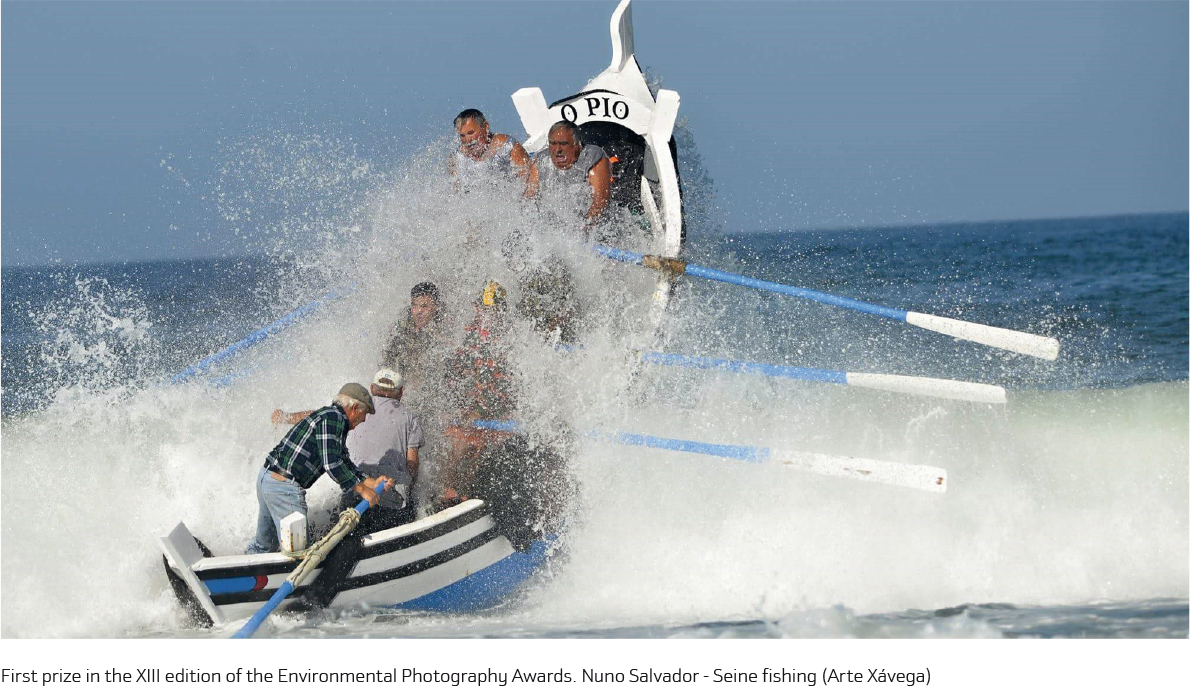
Strategy for climate change
Bankinter has a good rating in the sustainability indexes with regard to its climate change strategy, although it is aware that the expectations of its stakeholders are increasing. Also, in 2018 the new Climate Change Law will be published and there are recommendations of the Financial Stability Board which indicate that financial institutions need to manage climate change risks and opportunities in the short, medium and long term.
In the challenge that climate change raises, every actor must identify their role. And although the financial sector is not a carbon-intensive industry, the financial institutions have a major role in the transition to a low-carbon economy.
Therefore, the Bank's responsibility to the environment dos not rest so much in managing the direct impact of its activity on its surroundings (something which it has been managing for over a decade), but rather in its identification and management of its indirect impact, in other words, that which is created by the application of its financing and lending policies.
Bankinter has defined a road map for itself to become carbon neutral that includes formulas both for the reduction of emissions through eco-efficiency programmes, and for neutralisation (green energy purchase), and offsetting (indirect purchase of carbon rights for reforestation and conservation projects).
At the same time it is working on identifying its indirect impacts, that is, in ascertaining its actual contribution to climate change and the loss of biodiversity.
In this regard, Bankinter is leading the pilot project in Spain together with the Natural Capital Coalition (an initiative driven by the United Nations Environment Programme), to develop a specific guide for the financial sector to help the impacts on natural capital to be identified and managed: the ‘Natural Capital Protocol guide for the financial sector’. This project will show:

- What the environmental impact of their investment policies is in relation to natural capital, not only in terms of emissions, but also of the impact on terrestrial and marine biodiversity, and on natural resources (such as water and land use).
- What the weight and risk of each of the sectors in which it invests is, with respect to future regulations.
Carbon Footprint
Bankinter has been calculating its overall carbon footprint since 2009 in its three emission ranges: direct (consumption of fossil fuels and possible leakage of refrigerant gases), indirect (electricity consumption) and induced (travel and paper consumption, among other impacts).
In 2017, Bankinter's calculation of its organisational carbon footprint, this time including the Bank's business in Portugal, was verified by an external company, SGS, in accordance with the Greenhouse Gas Protocol and in line with the requirements of the Intergovernmental Panel on Climate Change.
Bankinter once again registered its carbon footprint (the one calculated for 2016) in the Ministry of the Environment's Carbon Footprint Registry, once again being awarded the ‘Reduzco’ seal for having reduced the intensity of its emissions in recent years.
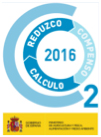
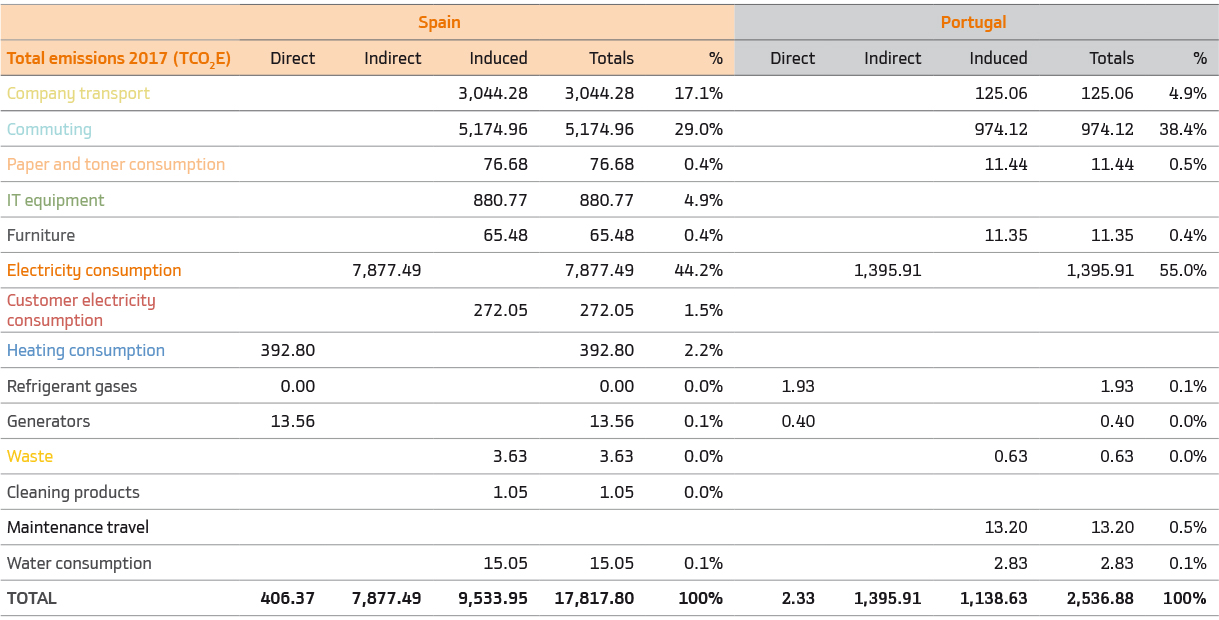
In 2017, Bankinter's business in Spain produced a total of 17,817.80 tonnes of CO2 equivalent, 3.8 tonnes CO2/per employee (down 0.2% on 2016).
Scope 1 (direct) emissions totalled 406.4 tonnes of CO2 in Spain. This is a 2.5% reduction on 2016 in absolute terms. These emissions declined by 5.8% in terms of emissions per employee.
Scope 2 (indirect) emissions increased slightly by 0.7% in absolute terms. However, emissions per employee fell by 2.7%. Total emissions in this scope are 7.887,5 tonnes of CO2 equivalent (1.7 tonnes CO2 per employee).
Total scope 1 and 2 emissions per employee fell by 2.8% with respect to 2016, thanks to the various energy efficiency measures implemented in recent years, such as the shift to LED lighting, improvements in automation and HVAC and the replacement of equipment with more eco-efficient designs.
Scope 3 (induced) emissions increased by 5.7% (2.2% per employee), mainly due to the acquisitions of IT equipment and business trips due to increased commercial activity, in line with the financial results presented by the entity in 2017.
In the case of the Bank's activity in Portugal, the direct emissions totalled 2,33 tonnes of CO2 (0.02 tonnes of CO2 per employee), a total of 1,395.91 tonnes of CO2 (1.6 tonnes per employee) in indirect emissions and a total of 1.138,63 tonnes of CO2 (1.3 tonnes per employee) in induced emissions. NB. These data are not comparable with those for 2016, as the banking business in Portugal only began in 2Q 16.
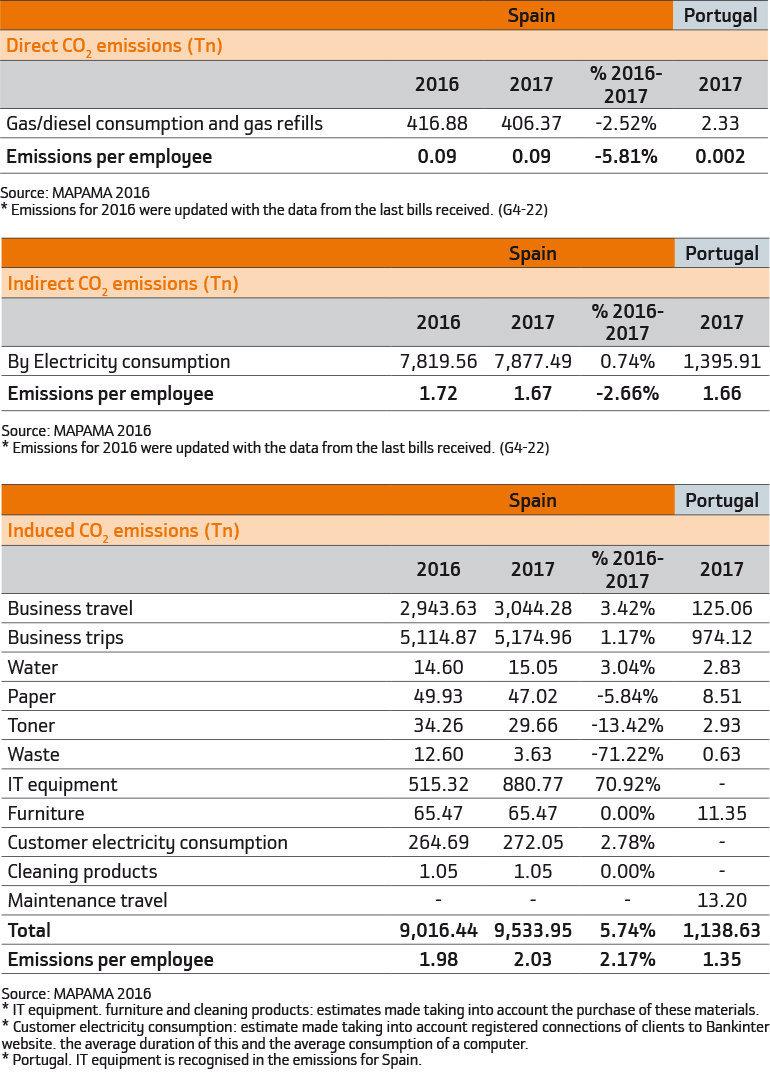
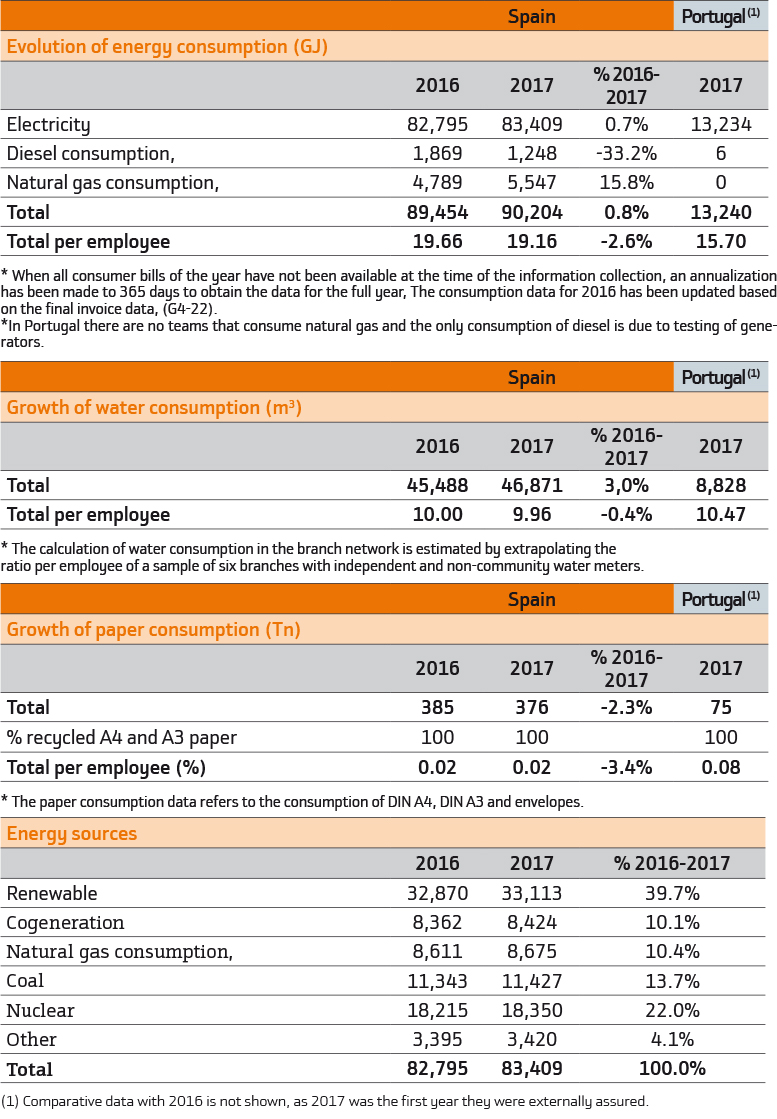
Indicators of eco-efficiency and sustainable use of resources
The company has identified the main eco-efficiency indicators of its activity to be measured and controlled so as to implement all necessary measures to ensure optimum environmental performance. This means minimising its carbon footprint and in the strategy for mitigating climate change.
Two important milestones occurred in 2017 which had an effect on the trends shown in environmental indicators: the inauguration of the new corporate headquarters in Alcobendas, Madrid and the transfer of most of central services in Portugal to the headquarters in Marques de Pombal, Lisbon. It is expected that in 2018, when both headquarters are both fully operational, there will be a return to the normal downward trend of all the environmental indicators.
Indirect energy consumption by the Bank is from electricity consumption. This is the main source used by Bankinter (93% of total energy consumed) and its consumption has gradually been reduced in recent years as a result of the savings measures adopted, which have enabled a fall of 2,1% in consumption per employee with respect to 2016.
At the end of 2016, energy audits were carried out at the Bank's buildings as required under prevailing legislation to assess the energy management carried out so far (such as the upgrade of equipment to more efficient models, replacement of lightbulbs with LEDs and smart meters for consumption) and established continuous improvement plans for the future, which have started.
The distribution of electricity consumption by energy sources has been determined according to the structure of energy sources in Spain, and is calculated according to the Spanish electricity mix published by Red Eléctrica de España for 2016.
In terms of consumption of natural gas and diesel, increases (2%) have been identified in absolute terms in relation to 2016, due, in large part to the increase in staff in the Bank's main buildings (there has been a fall of 1.4% in consumption per employee in relative terms).
However, it should be noted that the consumption of these fossil fuels represents only 7% of the total energy consumed by Bankinter in Spain.
In absolute terms, the Bank's energy consumption in Spain has increased by 0.8%. However, this has meant a 2.6% reduction in energy consumption per employee, which gives an idea of the efforts being made in eco-efficiency improvements.
The tables show the comparison of consumption data for Bankinter in Spain in relation to 2016, and data on the activity of Bankinter in Portugal for 2017.
Bankinter acquires paper according to demanding environmental criteria. It is 100% recycled and bears the Blue Angel and Nordic Swan ecolabels.
Among the measures that the Bank has implemented for the reduction of paper consumption, one of the most notable is the biometric signature solution, which was set up in fixed positions in branch offices and which has been extended in recent years to various operations and products, such as: investment fund agreements, current accounts, deposits, pension plans and so on. Tablets have been distributed among office employees so that clients can carry out operations with a digital signature.

Another important milestone in 2017, related to this aspect was the digitalisation of the process of hiring employees. As well as the digital signature of the contract, all the documentation associated with each employee goes to forms part of a personal digital archive, thereby reducing the paper requirements.
In addition, customer information campaigns have been maintained to replace paper correspondence receipt with the web correspondence model.
Thanks to these savings measures, there has been a year on year decline of 2.3% in paper consumption in Spain compared with 2016 (3.4% per employee).
In the case of electronic waste, the replacement of existing with more efficient equipment, the management of confidential information equipment and the start of activity in Portugal influenced the large quantity of this type of waste managed in 2016. In 2017, these levels returned to normal.
In 2017, Bankinter offset its annual direct emissions of 2016 from its business activity in Spain and Portugal (441 tonnes of CO2) through the Zero CO2 initiative of the Ecology and Development Foundation in the Conservation of the Amazon project in Madre de Dios in Peru.
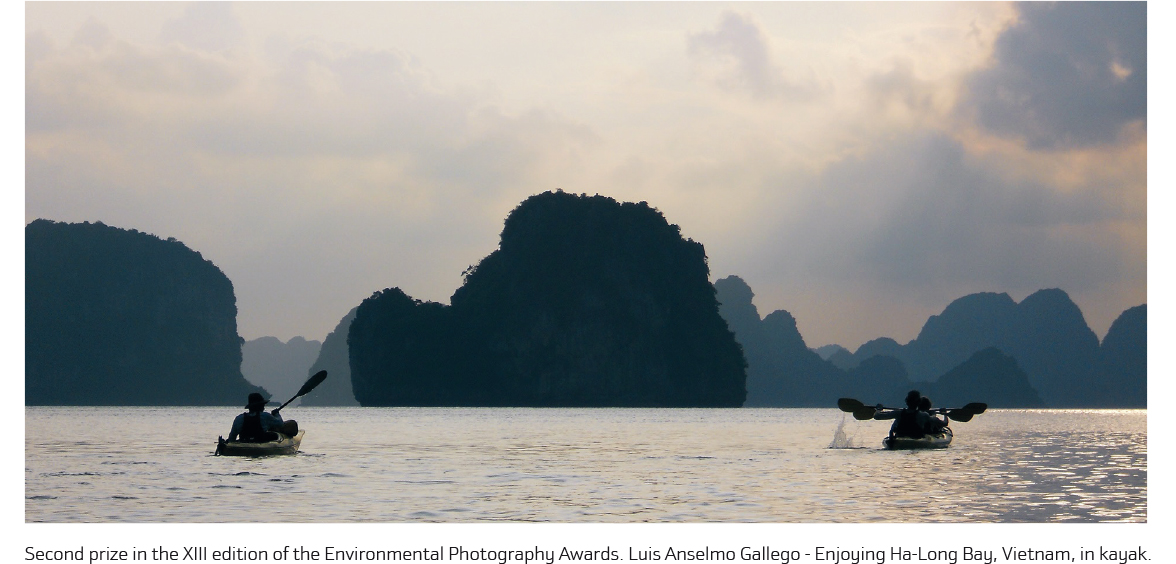
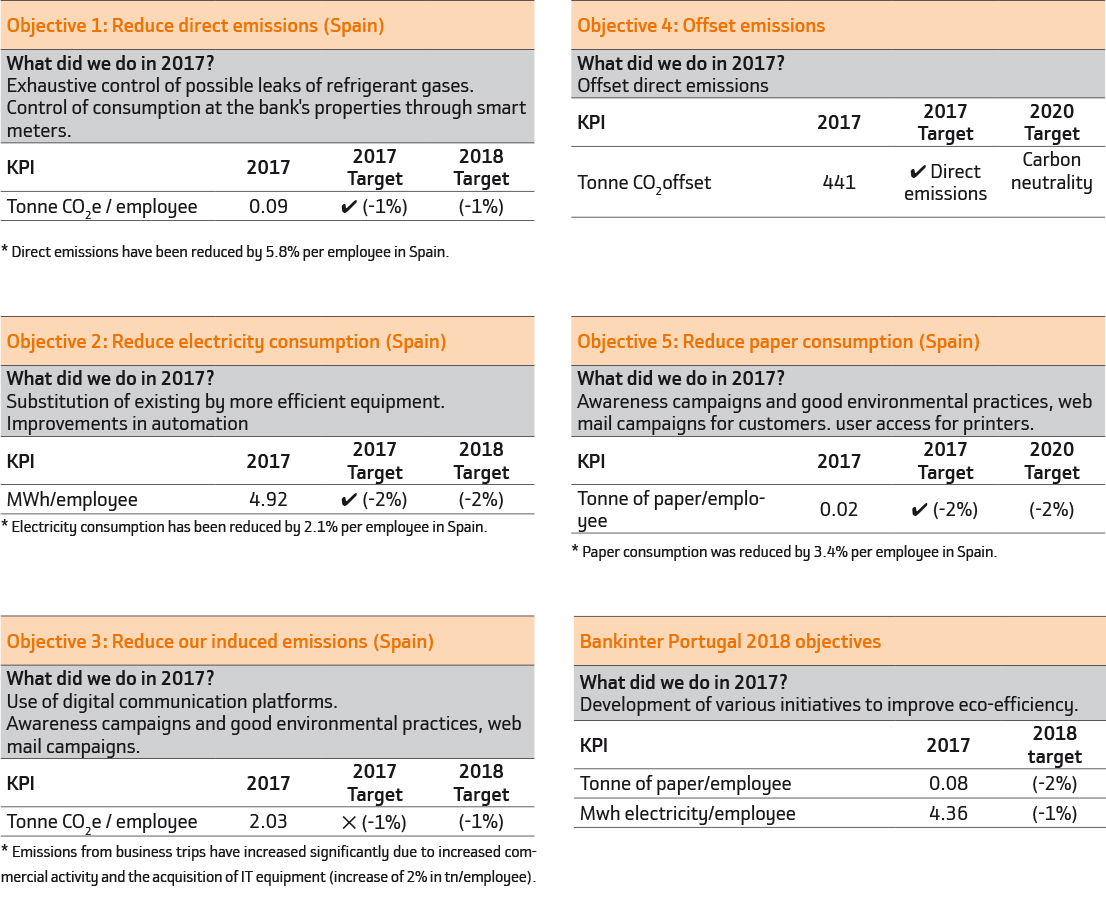
Environmental management system
Bankinter has an environmental management system (EMS), certified according to the UNE EN ISO 14001, standard to guarantee the continuous improvement of its environmental performance. During 2017, this system was adapted to the new version of the standard published in 2015 and the scope was extended to include the new building in Alcobendas. This means that the management system currently includes the Banks four landmark buildings in Madrid (Paseo de la Castellana, Tres Cantos, the two buildings in Alcobendas), and a branch office.
The Internal Audit area participates in the annual verification process required for certification.
In Spain, 42% of the bank's staff is covered by this environmental certification. Portugal too has a certified environmental management system, which in 2017 saw its scope extended to include the new headquarters in Marqués de Pombal, Lisbon (it also includes the Torre Oriente building) and covers 49% of the workforce. In total, 43% of the bank's workforce is covered by this certification.
In its annual environmental management programme, Bankinter includes a series of objectives and goals aimed at optimising consumption and correct waste management; the reduction of emissions to the atmosphere and the programming of communication campaigns, awareness-raising and training of employees on good environmental practices. These are detailed below:

Influence on stakeholders
The Bank has different communication channels, both internal and external, for the circulation of its various social and environmental initiatives, thus promoting the participation of all its stakeholders.
In addition to this annual report, the environmental portal and the blog, which offers opinion, reflection and debate between all employees, are also available.
The awareness-raising actions targeted at employees include the following:
Environmental website. Provides the Bank's workforce with news about activities of both internal and external environmental interest. Employees also have a suggestion box available to them.
Sustainability section in the Bankinter blog. This is an independent section whose publications are also disseminated through the Bank's social networks (Facebook, Twitter, Linkedin and Google+).
Collaboration in and financing of workshops in support of young green entrepreneurs, organised by the start-up Greenweekend. In 2017, Bankinter collaborated in five events.
XIII edition of the Environmental Photography Awards. The event, which was held in 2017 under the slogan ‘Sustainable Tourism‘, attracted entries from employees from Spain and Portugal.
Environmental Photography Awards in social networks. For the first time, an environmental photography competition was held for the Bank's followers on social networks with the slogan ‘Sustainable Tourism’. The competition was well received and over 800 photographs were sent in.
Support for ‘Earth Hour’ campaign. This is a WWF initiative to reduce CO2 emissions. To support it, the lighting of all Bank properties was turned off and various other devices were disconnected. The participation of employees and customers was also encouraged.
Eco-efficiency Prize in Portugal, a competition where employees suggest their ideas for internal eco-efficiency.
Bankinter has continued participating in the Climate Change Cluster promoted by WBCSD (World Business Council for Sustainable Development). It forms part of the cluster of 50 companies from various sectors. Throughout 2017, the group has focused in particular on the impact of climate change on cities, the upcoming Climate Change Law in Spain and the role that companies will play in that, along with the possible ways companies can adapt to climate change.














